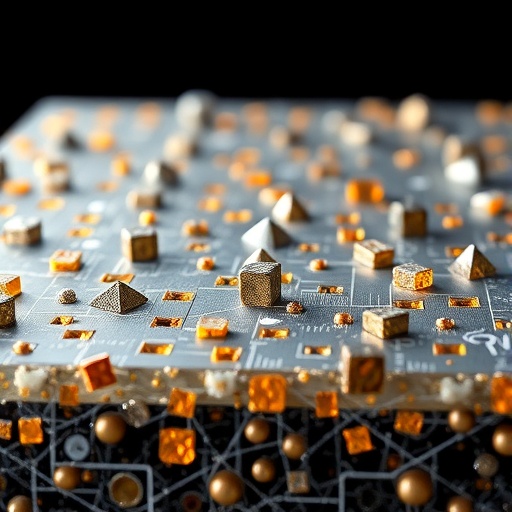In the ever-evolving landscape of energy storage technologies, the quest for achieving better battery performance continues to gain momentum. A pivotal area of focus has been the suppression of lithium dendrite growth in lithium-ion batteries. Dendrites can lead to short circuits and ultimately battery failure, posing significant safety hazards. In an innovative study published in Ionics, researchers have unveiled a simple yet effective method to construct a silver/gold (Ag/Au) alloy interface layer that holds great promise in mitigating this critical issue.
In this pioneering research, the authors explore the electrochemical behavior of lithium during the charging and discharging cycles of batteries. One of the central themes is the detrimental impact of dendritic structures that spontaneously form on the lithium anode. These structures not only diminish the efficiency of the battery but also shorten its lifespan. By introducing an alloy interface layer, the researchers provide an effective physical barrier that modifies the lithium plating morphology.
The Ag/Au alloy serves as a robust interface that helps guide the uniform deposition of lithium ions during the plating process. Unlike conventional lithium plating, which often results in uneven growth and dendritic structures, the alloy layer encourages a smoother, more controllable deposition of lithium. This not only enhances the overall performance of the battery but also significantly prolongs its life cycle.
.adsslot_BLnVIK4bQw{ width:728px !important; height:90px !important; }
@media (max-width:1199px) { .adsslot_BLnVIK4bQw{ width:468px !important; height:60px !important; } }
@media (max-width:767px) { .adsslot_BLnVIK4bQw{ width:320px !important; height:50px !important; } }
ADVERTISEMENT
Through meticulous experimentation, the researchers established a correlation between the properties of the alloy layer and its effectiveness in suppressing dendrite growth. By varying the concentrations of silver and gold in the alloy, they were able to fine-tune the electrochemical properties to optimize lithium ion flow. The results revealed that the optimal composition dramatically reduced dendritic growth, thereby enhancing the battery’s safety and performance.
The study emphasizes the significance of structural and electrochemical stability in energy storage materials. Researchers employed advanced characterization techniques such as scanning electron microscopy and transmission electron microscopy to evaluate the surface morphology of the lithium plating. These methods revealed that the presence of the Ag/Au alloy layer dramatically alters the surface characteristics of the lithium anode, leading to a more uniform lithium deposition and a notable reduction in dendritic formations.
In addition to its role in dendrite suppression, the Ag/Au interface layer also contributes to improved conductivity. Successful incorporation of the alloy interface allows for better ion transfer and electronic conduction. Enhanced electrical conductivity is crucial for increasing the overall efficiency of lithium-ion batteries, which is particularly important in applications where rapid charging and discharging are necessary.
The researchers also undertook a comprehensive evaluation of the long-term cycling stability of batteries featuring Ag/Au alloy layers. The data demonstrated that batteries incorporating this innovative interface exhibited significantly improved cycle life compared to those without the alloy layer. This finding is instrumental in the pursuit of developing high-performance batteries that can withstand prolonged use without a decline in functionality.
As the study progresses, it delves into potential applications for this technology in real-world energy storage systems. The integration of Ag/Au alloy interlayers could pave the way for safer and more efficient battery systems for electric vehicles, portable electronics, and renewable energy storage solutions. This could revolutionize the market, offering consumers not only enhanced performance but also peace of mind regarding battery safety.
The implications of this research extend beyond academic curiosity; they touch on critical environmental and technological trends. With the global push towards cleaner energy solutions, improving battery technology plays a central role in the transition to renewable energy sources. The findings of this study could significantly impact how batteries are manufactured and utilized in various sectors, underscoring the importance of research and development in the field.
The researchers conclude by highlighting the prospect of extending their investigations into other alloy combinations that might offer even greater efficiencies in battery performance. This ongoing exploration signifies an exciting frontier in battery technology, suggesting that there remain vast opportunities for innovation and improvement.
The narrative created by this groundbreaking study serves as a clarion call for continued investment in battery research. As scientists and engineers work hand-in-hand to solve existing challenges, the future of energy storage appears increasingly bright. The introduction of materials like the Ag/Au alloy interface is just one of many exciting developments that promise to reshape our approach to energy utilization.
As further studies emerge on this topic, it is likely that we will witness more transformative advancements that will help usher in a new era of battery technology, characterized by safety, efficiency, and sustainability. In this pursuit, every small improvement counts—each research effort contributes to a larger mosaic of progress in achieving a more energy-efficient world.
The narrative presented encapsulates the essence of innovation in the energy storage domain, demonstrating how fundamental research can lead to practical solutions that directly impact our everyday lives. With the growing intersection of science and technology, the path forward is laden with potential that beckons exploration, bringing us closer to a future powered by advanced battery systems.
Subject of Research: Lithium dendrite growth suppression in lithium-ion batteries through Ag/Au alloy interface layers.
Article Title: Simple construction of Ag/Au alloy interface layer for suppressing lithium dendrite growth.
Article References:
Ni, Z., Li, J., Yang, W. et al. Simple construction of Ag/Au alloy interface layer for suppressing lithium dendrite growth.
Ionics (2025). https://doi.org/10.1007/s11581-025-06559-9
Image Credits: AI Generated
DOI: https://doi.org/10.1007/s11581-025-06559-9
Keywords: Lithium-ion battery, lithium dendrite, Ag/Au alloy, battery performance, energy storage technology.
Tags: alloy layer effects on lithium platingbattery safety hazardsdendritic structures in batterieselectrochemical behavior of lithiumenergy storage technology advancementsimproved battery lifespaninnovative battery research solutionslithium dendrite suppressionlithium plating morphologylithium-ion battery performancesilver gold alloy interfaceuniform lithium deposition





